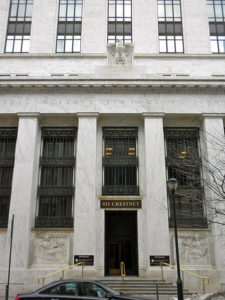
The “Old Philly” Federal Reserve Building, now used as a hospital.
The discount window refers to the Federal Reserve practice of making short-term loans to banks. These loans are usually overnight and collateralized. When a bank experiences a short-term liquidity shortfall, it may turn to the Fed for a quick infusion of cash. Generally, banks prefer to borrow from other banks at the much lower federal funds rate; banks will only borrow at the much higher discount rate from the discount window during a time of crisis.
Historically, the term “discount window” comes from literal windows that bank employees would visit in the lobby of a Federal Reserve branch. Discount windows become very important in times of economic distress when all banks are experiencing liquidity problems. For instance, during the tech bubble burst in 2001, the discount window hit its highest level in 15 years. The discount window again became important during the 2008 financial crisis, during which the Fed extended lending periods from overnight to 90 days, and lowered the discount rate to very near the federal funds rate.

Recent Comments